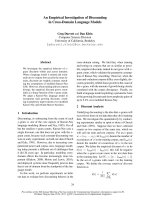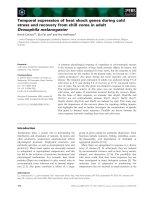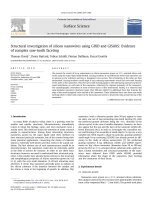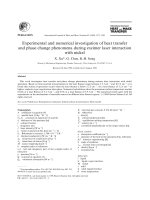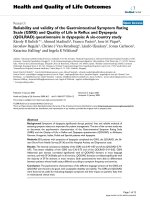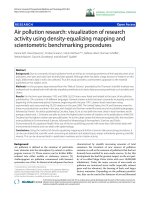Investigation of heat therapies using multi scale models and statistical methods
Bạn đang xem bản rút gọn của tài liệu. Xem và tải ngay bản đầy đủ của tài liệu tại đây (2.31 MB, 136 trang )
INVESTIGATION OF HEAT THERAPIES USING MULTI-
SCALE MODELS AND STATISTICAL METHODS
HUANG WEI HSUAN
B.Eng (Hons.), NUS
A THESIS SUBMITTED
FOR THE DEGREE OF DOCTOR OF PHILOSOPHY
DEPARTMENT OF MECHANICAL ENGINEERING
NATIONAL UNVERSITY OF SINGAPORE
2013
i
DECLARATION
I hereby declare that the thesis is my original work and it has been written by me in
its entirety. I have duly acknowledged all the sources of information which have
been used in the thesis.
This thesis has also not been submitted for any degree in any university previously.
________________________________
Huang Wei Hsuan
14 January 2013
ii
Acknowledgement
I would like to express my gratitude to my supervisors, Asst. Professor CHUI
Chee Kong from the Department of Mechanical Engineering, NUS and Assoc. Professor
CHANG KY Stephen from the Department of Surgery. Without their guidance and
mentorship, it would not have been possible for me to accomplish such interdisciplinary
work. I also like to thank Professor KOBAYAHSHI Etsuko from University of Tokyo for
her support in JSPS.
I would also like to thank the people from my research group and members of my
lab, Control and Mechatronics Lab 1, including Mr. WEN Rong (ME,NUS), Mr. YANG
Liang Jing (ME,NUS), Mr. CHNG Chin Boon (ME,NUS), Mr. LEE Chun Xiong
(ME,NUS), Mr. XIONG Linfei (ME,NUS), Mr. FU Yabo (ME, NUS), Ms. WU Zimei
(ME,NUS), Dr. NGUYEN Phu binh (ECE, NUS), and many others.
Last but not least, I’ll like to thank my family (Dad, Mom and Sister), friends and
loved ones for their support. Without their consideration and endless supports, I would
not be able to devote myself fully to the PhD program.
iii
Table of Contents
Summary v
List of Figures vii
Abbreviations x
1 Introduction 1
2 Literature Review 6
2.1 Basics of RF ablation 6
2.2 Mechanism of tissue injury 13
2.3 The role of bioimpedance in RF ablation 18
2.4 Blood flow modeling 21
2.5 Multi-scale modeling 25
2.6 Stochastic finite element method 29
3 Multiscale Model for Bioimpedance Modeling 31
3.1 Multi-scale modeling 31
3.2 Bioimpedance modeling 33
3.3 Multi-scale bioimpedance model 39
3.4 Simulations and results 44
3.5 Discussion 46
4 RF Ablation and Mechanical Properties 49
4.1 RF ablation 49
4.2 Proposed model 51
4.2.1 Model description 51
4.2.2 Simulation 53
4.2.3 Implementation 54
4.3 Experiments 56
4.3.1 Experimental setup 56
4.3.2 Tissue sample size vs. time for ablation 57
4.3.3 Ablation time vs. tissue mechanical property 58
4.4 Discussions 62
5 Large Tumors Kinetics 65
5.1 Large tumor treatment 65
5.2 Large tumor planning 67
5.3 Stochastic finite element methods 71
iv
5.4 Surgical planning for tumor ablation 78
5.5 Results and discussions 83
6 Integrated Device for Ablation, Blood Sensing and Division 86
6.1 Hepatectomy and tissue division methods 86
6.2 Integrated device prototype 89
6.2.1 Overview 89
6.2.2 Material selection and prototype design 91
6.2.3 Prototype assembly 91
6.2.4 Ablation mechanism and optimal electrode placement 92
6.2.5 Blood flow detection 95
6.2.6 Resection mechanism 98
6.3 Experiments 99
6.3.1 In-vitro experiments 99
6.3.2 In-vivo experiments 100
6.4 Discussion 101
7 Conclusion 102
7.1 Contributions 102
7.2 Future work 105
7.3 Conclusion 106
References 108
Publications 124
v
SUMMARY
Radio-frequency (RF) ablation is commonly used for hepatic carcinoma or liver
tumor treatment due to its minimal invasiveness and simplicity. RF ablation is the
application of a high frequency (550KHz) electric voltage within a target biological tissue
which generates high current density and hence ionic agitation and frictional heating. The
increase in temperature leads to coagulative necrosis in liver tissue or tumor.
Understanding the science of ablation is valuable for hyperthermia treatment. It is
useful in predicting the outcome of RF ablation, minimizing healthy tissue damage and
optimizing RF ablation procedure. Quantifying heat transfer for RF ablation can be
achieved by Penne’s bioheat equation, which is a partial differential equation relating
Specific Adsorption Rate (SAR) power to temperature. The Penne’s bioheat equation can
be solved using finite element method with input comprising tissue material properties
such as heat transfer coefficient, conductivity, etc.
Tissue impedance plays an important role in the simulation of RF ablation, due to
the dependence of joule heating on conductivity. A multi-scale geometrical impedance
model was proposed to mimic the impedance dispersion of liver tissue. This model is
built from cellular scale and scaled upwards to liver lobule level and finally the tissue
level. The model is able to model differences in blood flow in the tissue which can be
useful in blood detection technologies. The theoretical model matches the impedance
dispersion data better than that of the classic Cole-Cole model with sound physiological
explanation.
RF ablation results in tissue injury causing changes in tissue cellular structures at
micro level, and its physical properties at macro level. The relationship between tissue
vi
mechanical properties and ablation was studied. Liver tissue stiffness is larger for ablated
tissue at small strains, and eventually leveled when strain increases, exhibiting
viscoelastic properties. A novel 3D plot was used to illustrate the relationship between
tissue stress-strain relationship, tissue bulk electrical impedance and ablation time. The
plot correlates the relationship between tissue injury and changes in physical properties.
RF ablation has been used clinically for liver tumor ablation. However, there is a
limitation for large tumor (3~8cm in diameter) ablation which requires multiple electrode
insertion and ablation. Surgical planning is important in determining the appropriate
overlapping of RF ablation to prevent relapse while minimizing healthy tissue damages.
A novel Stochastic Finite Element (SFE) method was incorporated into large tumor RF
ablation surgical planning. Due to variation in tissue properties and sample variations,
stochastic FE method was proposed for a non-deterministic simulation result.
Liver resection remains the gold standard in liver cancer treatment, and RF
ablation has been used to assist liver resection surgery (hepatectomy) to minimize blood
losses during surgery. RF is used to coagulate blood vessels in prevention of bleeding
during surgical resection. An integrated RF ablation and resection laparoscopic device
was designed and fabricated to overcome difficulties faced during tissue division in
laparoscopy surgery. The device was tested in-vivo on a porcine model with a Laser
Doppler sensor integrated for blood flow detection. The device was able to detect the
presence of blood prior to resection and informs the user with the help of a Graphic User
Interface created on a PC. Results from the device show competitiveness with existing
commercial products in both operation time and less blood losses.
vii
LIST OF FIGURES
Figure 2.1: Bipolar electrode electric potential distribution for a bipolar RF catheter
application on biological tissue 7
Figure 2.2. Finite element analysis of bi-polar RF ablation 10
Figure 2.3. Illustration of Chang and Nguyen model (Chang 2004) 11
Figure 2.4: Changes in microstructure for tissue undergoing ablation. Increase in
interstitial spacing and shrinkage in muscle fibre (Wierwille 2010) 14
Figure 2.5. Plot of conductance changes with time. (Gersing 1999) 21
Figure 2.6. Sakamoto’s model of dielectric of red blood cell (Sakamoto 1999) 23
Figure 2.7. Equivalent circuit for flowing blood (Sakamoto 1999) 23
Figure 3.1. Bioimpedance dispersion (Schwan 1999) 33
Figure 3.2. Comparison between Debye and Cole-Cole model (Cole 1941) 35
Figure 3.3. Hierarchical model (Dissado 1905) 38
Figure 3.4. Proposed multi-scale impedance model 40
Figure 3.5. Liver cell model. (left) low frequency behavior of liver cell (right) high
frequency behavior of liver cell. 41
Figure 3.6. Liver lobule model. (left) low frequency behavior of liver lobule (right) high
frequency behavior of liver lobule. 42
Figure 3.7. Liver tissue model. (left) low frequency behavior of liver tissue (right) high
frequency behavior of liver tissue. 44
Figure 3.8. Plot of the permittivity magnitude vs frequency. Dashed line representing
proposed model output, solid line representing Cole-Cole model output. …………… 45
viii
Figure 3.9. Plot of permittivity response with decreasing blood flow. Red line represents
no blood flow in model. 46
Figure 4.1. Proposed electrical equivalent model 52
Figure 4.2. Simulation of proposed model 54
Figure 4.3. Workflow of implementing model 55
Figure 4.4. Rita 1500X RF generator 56
Figure 4.5. Test rig and controlling PC with Labview 57
Figure 4.6: Comparison between experimental data and simulated results 58
Figure 4.7. Compression test results fitted with combined energy function 60
Figure 4.8. Electrical property response with ablation time 60
Figure 4 9. 3D plot of mechanical and electrical properties 61
Figure 5.1. Distribution of tissue area exceeding cytotic temperature (a) Test for
normality (b) Results from Stochastic Finite Element Analysis. 74
Figure 5.2. Results from FEM (a) Electric field and (b) Temperature field due to Bi-polar
RF ablation 77
Figure 5.3. Flow chart of RFA planning system 81
Figure 5.4. (a) Tumor generated: Tumor (blue), vessels (red) & tissue (pink) and (b)
Tumor subdivision with 1cm margin 82
Figure 5.5. Temperature distribution for large tumor surgical planning 84
Figure 6.1.a Tissue ablation and division prototype device 90
Figure 6.1.b. Modular design of the prototype device. 90
Figure 6.2. Position of various parts 92
ix
Figure 6.3. Finite Element Results. (a) Temperature distribution for 4-electrodes RF
ablation. (b) Temperature distribution for 2-electrodes RF ablation. 94
Figure 6.4. User interface for LDF information display 96
Figure 6.5. (a) Calibration of LDF Sensor with water (b) Calibration of LDF sensor with
milk 97
Figure 6.6. Knife blade visibility. (L to R) Small square blade, large surgical blade, large
square blade 99
x
ABBREVIATIONS
ASTC: Advance Surgical Training Centre 98
AVNRT: AV Nodal Reentrant Tachycardia 20
CT: Computed Tomography 98
ECG: Electrocardiography 33
ECM: Extra Cellular Matrix 27
ECT: Electrical Capacitance Tomography 61
EIT: Electrical Impedance Tomography 19
FDA: Food and Drug Administration 89
FE: Finite Element 11
LDF: Laser Doppler Flow 4
MRE: Magnetic Resonance Elastography 3
MRI: Magnetic Resonance Imaging 66
ODE: Ordinary Differential Equation 27
PDE: Partial Differential Equation 27
POM: Polyoxymethylene 89
RBC: Red Blood Cell 93
RF: Radio-Frequency 1
SAR: Specific Adsorption Rate 11
SFE: Stochastic Finite Element 29
TLM: Transmission Line Method 12
1
Chapter 1
1 INTRODUCTION
Hyperthermia therapies are commonly used for cancer treatment. These therapies
involve an elevation in tissue temperature (or reduction in the case of cryo-ablation) to
induce cell necrosis in cancerous tumors. Temperature related tissue injuries are the basic
mechanism present in hyperthermia treatments. These methods are effective due to the
cytotoxicity observed in cells above a threshold temperature. In addition, S-phase cells
which are the most ionizing radiation resistant are most sensitive to hyperthermia
(Craciunescu 1999). There are many methods for energy deposition in hyperthermia
treatment including Ultrasound ablation, Laser ablation, Radiofrequency ablation and
Microwave ablation, etc. This thesis concentrates on Radio-Frequency (RF) ablation and
mainly therapeutic treatments for hepatic malignancies.
In RF ablation, electrical pulses (~500 KHz) are used to induce Joule heating and
necrosis to tissue and cancerous cells. The principle of RF ablation is to generate ionic
agitation and frictional heating thus leading to coagulative necrosis in tissues. The
electric field lines that are induced from the electrode tip by the applied voltage induce an
electric force on the charged ions within the electrolytic medium of the liver tissue. This
induced force produces a motion that causes ions in the tissue to rub against the
surrounding fluid medium, causing friction and heating effect. The temperature at any
point in the affected tissue zone is governed by the total frictional power input at the
2
point mediated by thermal conduction and a convective factor, which is primarily blood
circulation.
The ultimate strategy of RF thermal tumor ablation therapy for hepatic and other
malignancies has two main objectives (Adam 2009). Firstly, through the application of
RF energy, the goal was to completely eradicate all malignant cells within a designated
area. Based on clinical studies examining tumor progression for patients who underwent
surgical resection procedure, and confirmation of viable malignant cells beyond visible
tumor boundaries, tumor ablation therapies should attempt to include at least a 1.0cm
“ablative” margin of seemingly normal tissue for liver. Secondly, while complete
eradication of tumor is of primary importance, specificity and precision of RF therapy is
also required. One significant advantage of RF thermal ablation over conventional
standard surgical resection is the minimal blood losses and potential minimal amount of
normal tissue damage/loss that occurs.
Tissue temperature distribution is an important study in understanding RF
ablation. Penne’s bioheat equation is the most commonly cited model for RF ablation
modeling and can be solved with methods such as finite element analysis to prognosticate
temperature distribution of ablated tissue. Tissue temperature can then be related to
degrees of cell injury categorized into mass ablation, carbonization, water vaporization,
protein denaturation and membrane dissociation (Thomsen 2009).
In general, an increase in temperature over a threshold, results in a change in
tissue cell structure, cellular content, moisture loss and protein denaturalization. The
change in structure leads to a change in mechanical properties due to skeletal changes in
cells. Studies reported differences in mechanical property between native and thermally
3
damaged liver. In our experiments, observations were also made for ablation time, to be
positively related to a change in tissue stiffness. Ablation time is a good approximation
for tissue temperature, and quantitative relationship can be established between
temperature and mechanical properties. Tissue injuries are often quantified in the micro
scale by observing structures such as cells or their equivalent during necrosis. Optical and
fluorescence characteristics of tissue, histochemical markers or Optical Coherence
Tomography (OCT) are methods available for quantifying cell death (Lin 2003,
Wierwille 2010). However, mechanical properties of tissue are observed in the macro
level such as tissue level for most pragmatic purpose. Test rigs such as a compression
machine, Magnetic Resonance Elastography (MRE) and ultrasound elastography are
choices for quantifying mechanical properties both in-vivo and in-vitro. Relationship
between tissue injury and tissue mechanical properties helps us relate the effect of an
alteration of cell in a micro level (1 to 100 microns) on its macro level (1mm to 10cm)
equivalent. A study of structural changes in the micro level, such as the skeletal structure
of cells and extracellular matrix are often less commonplace in clinical practice, but only
for specific interest groups.
Liver resection is the gold standard for hepatic carcinoma treatment. A new
technique in liver resection was developed by Habib et al
(2006) to synergize radio-
frequency ablation and liver resection for significant reduction in blood losses during the
resection procedure. Radio-frequency ablation was first performed on the desired line of
resection on the liver and manual resection with surgical scalpel of the liver tissue
follows thereafter. Radio-frequency was used to induce frictional heating in the healthy
liver tissue and thus coagulation for minimizing blood loss during liver resection. The
4
technique also results in reduction of the length of the anesthetic time and the operating
time. To achieve the effect of coagulation in normal liver parenchyma is much faster than
that in tumor tissue. Coagulative necrosis in liver tumor tissue takes about 20 minutes for
one probe application, but only 40 seconds to coagulate the same amount of normal liver
tissue hence making the procedure very fast. The technique eliminates the need for
intensive care unit facilities, and reduces the need to employ Pringle’s maneuver
(Milicevic 2008) which is often used for conventional tumor ablation for effective RF
heating but results in ischemia-reperfusion hepatocellular injury. Ultimately, the
technique results in less postoperative mortality and morbidity. However, there are some
limitations to the Habib’s technique. Firstly, Radio-Frequency energy should be applied
carefully near the hilum or the vena cava because of its potential damaging effect on
these structures. Secondly, healthy parenchymal tissue will be sacrificed for the resection
procedure. However, the regenerative capacity of residual normal liver tissue should
reduce the amount of potential damage by the technique. Thirdly, it is not possible for the
surgeon to be sure of the complete coagulation of the tissue along the cutting plane.
Hence, occasional blood losses will be encountered during operation.
A prototype was built to incorporate the Habib’s technique into a single device,
combining both procedures of radio-frequency ablation and hepatectomy. The prototype
enables a smooth surgical procedure of a Habib procedure in a compact and integrated
solution laparoscopically. It removes the need for switching between laparoscopic tools
during the surgery thus saving significant time and effort. A Laser Doppler Flow (LDF)
Sensor was integrated for blood flow detection after Radio-frequency ablation was
5
employed and is able to present real time graphical information to the surgeon during the
surgery.
The motivation of this thesis is to understand the science of RF ablation - to be
able to understand, model and simulate RF ablation, and to relate physical properties
changes with RF ablation. By doing so, the knowledge can be used to design and build
novel medical devices for their intended purpose. The several chapters in the thesis
addresses existing limitation in physical or methodological modeling of topics relating to
RF ablation with improved work that were also published.
This chapter introduces hyperthermia treatment with RF ablation and its
applications. The second chapter of the thesis covers literature reviews for the various
fields of RF ablation. This chapter provides background knowledge on the subsequent
chapters. The third chapter covers work in bio-impedance modeling with the proposal of
a geometry based, multi-scale model which models the frequency dispersion of hepatic
tissue impedance. Bioimpedance is related to the effectiveness of RF ablation and the
proposed model can be used in developing a blood sensing technology for the prototype
discussed in chapter six. The fourth chapter covers work in modeling the change in tissue
impedance due to RF ablation and the correlation between impedance, stiffness and
ablation duration. This chapter is also related to the optimization of RF ablation and is
applicable to chapter six. In chapter five, a statistical based stochastic finite element
method was demonstrated in large tumor RF ablation planning. The relevant contribution
of the thesis is discussed in chapter six in the building of a prototype device. The thesis is
wrapped up finally in chapter seven with the conclusion and the future of RF ablation
studies.
6
Chapter 2
2 LITERATURE REVIEW
This chapter reviews previous work in the field of Radio-frequency ablation as
well as related work in multi-scale modeling and bioimpedance. First section covers the
existing work in modeling RF ablation while the second section covers the mechanism of
tissue injury due to RF ablation. The third and fourth section covers existing work in
bioimpedance related to RF ablation and blood flow modeling. The fifth section covers a
short description of multi-scale model, which is the main modeling technique used in the
thesis. Lastly, statistical method in Finite Element analysis is briefly introduced.
2.1 Basics of RF ablation
Many forms of hyperthermia treatment exist in clinical practices -Radiofrequency
(RF) ablation, Microwave ablation, Laser ablation, Ultrasonic ablation and Cryoablation.
RF assisted methods have been widely used in the treatment for hepatocellular cancers,
breast tumors and cardiology treatments. The increase in temperature leads to coagulative
necrosis in tissue (Haemmerich 2003).
Catheters used for RF ablation are often needle electrodes for its high current
density. Catheters can be found in two forms - monopolar or bipolar electrodes.
Monopolar electrodes work on the principle of a single polarity electrode with a large
grounding pad attached to patients. The current density is highest at the electrode tip-
tissue interface where area of contact is small and decreases when current flows through
7
the body and exits from the grounding pad. Monopolar catheters enable electrode design
to be small and slim, hence suitable for percutaneous or minimally invasive procedures.
However due to the small area of contact, treatment area is limited. A possible way to
increase treatment area is an expandable prong design which consists of retractable
electrodes.
Figure 2.1: Bipolar electrode electric potential distribution for a bipolar RF catheter
application on biological tissue
Bipolar electrodes are electrode pairs with dual polarity for current flow (Figure
2.1). It does not require the grounding pad that is needed for monopolar catheters. Bipolar
electrodes can be arranged into electrode systems with 2 or more electrodes for large
treatment area. Due to the close distance between electrodes, there is higher current
density at the electrode-tissue interfaces and thus a higher and faster area of treatment in
comparison to monopolar catheters. The Electric potential of the target tissue zone is
govern by
, (2.1)
8
where
is the charge density, is the electric potential and
the permittivity.
Bipolar catheters can be used for open surgery or to be integrated into
laparoscopic devices (Chang 2011, Huang 2011). Haemmerich et al (2001) investigated
the differences between monopolar and bipolar RF ablation with the use of a finite
element model. It was concluded that the bipolar method creates larger lesions and is less
dependent on local inhomogeneity in liver tissue.
Lim et al (2010) studied the effect of different Radiofrequency waveform on
tumor ablation with blood vessel heat sink effect. RF waveforms such as half-sine, half-
square, half-exponential and damped sine wave were simulated. It was concluded that the
damped sine waveform creates the smallest RF lesion in volume while the half-sine wave
form is the most effective.
RF ablation is most commonly used to destroy tumorous cells as a form of direct
treatment. Tumors are subjected to cytotoxic temperature and results in cell necrosis.
However, there are other usages for RF ablation in medicine. Liver resection, also known
as hepatectomy, is the gold standard for liver tumor treatment. It is desirable to minimize
blood losses during liver resection procedure for best treatment survivability. Dr Habib
(Jiao 2006) pioneered a surgical procedure which uses RF ablation for hepatectomy. RF
ablation was first performed on the desired line of resection to form a plane of coagulated
tissue, followed by a manual resection with surgical scalpel. This reduces possible blood
losses during resection and hence relieving usage of surgical maneuvers such as the
Pringle maneuver (Milicevic 2008) which often results in results in ischemia-reperfusion
hepatocellular injury. The technique can be performed by clinician whom is familiar with
liver anatomy. The technique also results in reduction of the length of the anesthetic time
9
and the operating time as it is much faster to achieve coagulation in normal liver tissue
compared to tumors.
Another usage for RF ablation is in the treatment for large tumors (3~8cm in
diameter). Although Hepatectomy remains the gold standard for liver tumor treatment,
only a low percentage of patients are eligible for the procedure (Tranberg 2004). RF
ablation serves as a good alternative treatment for liver tumors due to its low invasiveness,
simplicity and cost effectiveness (Ni 2005). Large tumor ablation is performed by
overlapping zones of RF ablated tissue for full coverage of the tumor. In order to increase
RF ablation area, many methods were developed such as saline injection (Livraghi 1997)
for increased electrical conductivity, cooled electrodes to reduce charring (Goldberg 1996)
and bipolar array to increase treatment zone area (McGahan 1996).
Radio-frequency ablation involves heat transfer in tissue which will be the main
topic of discussion in this section. It is difficult to monitor actual temperature distribution
in the tumor. Hence, it is suggested that modeling should be used for better understanding
of the temperature distribution (Clegg 1993). Various works were done in modeling the
RF ablation process with Penne’s Bioheat Equation being the most commonly cited
(Craciunescu 1998). While Penne’s bioheat equation does not fully describe the full
physical process of RF ablation, it is a good approximation especially for hyperthermia
temperatures (Yang 2007). It is due to the temperature dependence of many different
physical parameters such as dielectric and thermal properties which is crucial for
simulation. Haemmerich (2001) suggested that Penne’s assumption of heat transfer
between tissue and blood occurs is not an accurate description. Nevertheless, the model
describes blood perfusion with good accuracy if no large vessels are near the area of
10
concern. This limitation does not adversely affect the accuracy of Penne’s model (Pennes
1948) in liver RF ablation as it is common to avoid the major vessel in the liver during
surgery. It is also worth noting that variable such as conductivity; current density and
blood perfusion do not change during ablation in Haemmerich’s work and is assumed to
be a constant in the model (6.4x10
-3
). A modified Pennes bioheat equation for RF
ablation simulation:
, (2.2)
where is the density, is the specific heat capacity of material, is the temperature,
is the thermal conductivity, is the current density, is the electric potential,
is the
blood density,
is the blood specific heat,
is the blood perfusion rate and
is the
blood temperature.
Figure 2.2. Finite element analysis of bi-polar RF ablation
11
Figure 2.3. Illustration of Chang and Nguyen model (Chang 2004)
Finite Element (FE) method was used for simulation (Figure 2.2). The simulation
incorporates the effect of Joule heating due to Electromagnetic energy which was not
present in Penne’s 1948 model. Chang and Nguyen attempted to model the radio
frequency ablation process in soft tissue by means of a two dimensional finite element
model (Chang 2004). The model takes into account both the temperature and electrical
conductivity dependence of the RF ablation process with respect to the tissue. The results
was compared to lesion sizes which involves iso-temperature contour as its definition and
the study concluded that temperature isotherms may not be the best representation for
actual tissue damage pattern. The model (Figure 2.3) has a close loop, self-updating
structure consisting of the Specific Adsorption Rate (SAR) - the amount of energy
absorbed by the tissue from the ablation needle, the Penne’s bioheat equation for
updating of tissue temperature, updating thermal conductivity of tissue and Arrhenius
Electromagnetics Solver
·σ(T) ϕ=0
Thermal Solver
ρC
p
(dT/dt)= ·kT+σ(T)| ϕ|2+P(Ω)
Source Voltage
V=V(t)
Update
Electrical
Conductivity
Update Tissue Damage
Update Perfusion State
12
equation to update the tissue damage and perfusion related. Tissue coagulation is
assumed to occur when damage equation reaches a certain threshold (Ω=4.6) and that
tissue coagulation is accompanied by the ceasing of perfusion. Once perfusion is stopped,
the convective part of heat transfer due to perfusion is no longer valid, and the perfusion
term is assumed to be zero.
Ahmed et al (2008) used an established computer simulation model of
radiofrequency ablation to characterize the combined effects of varying perfusion, and
electrical and thermal conductivity on RF heating. The varying electrical and thermal
conductivities are used to represent tissue, fats and saline injection. The different
parameters were changed to model the effect of RF heating in different scenarios. It was
concluded that greatest RF heating occurred when the ablation needle surrounded by
tissue and with an outer layer of fats. However, the model does not account for
coagulation of blood vessels and thus the stopping of perfusion. Solazzo et al (2005)
studied the effect of a varying background electrical conductivity to RF heating
effectiveness. The team concluded that there is a strong relationship between background
tissue and RF heating.
Bellia et al (2008) proposed the simulation of Penne’s bioheat equation with
transmission line method (TLM) and showed good agreement with other numerical
methods. Roper (2004) used an integral transformation to formulate a benchmark solution
for bioheat equation. Comparison of the benchmark solution with numerical solution
shows close matches. Yang et al (2007) proposed a new bioheat equation for microwave
ablation which includes tissue water evaporation, diffusion, vapor diffusion and
13
condensation due to the dominant of these physical processes when temperature reaches
100
o
C.
Arkin et al (1994) reviewed the different models proposed in modeling heat
transfer in blood perfused tissue. The model aids in better predicting hyperthermia
procedure which is relevant to the radiofrequency ablation technique we’re studying. Due
to the complex morphology of living tissues, hyperthermia modeling is often difficult and
requires simplifying assumptions to be drawn. Penne’s bioheat equation is inadequate in
accounting for actual thermal equilibrium process between flowing blood and tissue.
Penne’s bioheat equation assumes that heat transfer occurs only through vessel walls and
blood reaches tissue temperature immediately after entering the concerned vessel. Several
techniques were reviewed for their strength and weaknesses. It was concluded that
Pennes’ model might still be the best practical approach. However, the main problem
with bioheat transfer modeling remains the absence of measuring equipment capable of
reliable evaluation of tissue properties and their variations at small scale. In addition, the
model does not take into account denaturalization of the tissue causing structural changes
and fluid exchanges when hyperthermia treatment is applied.
2.2 Mechanism of tissue injury
Tissue temperature is a direct cause of tissue injury which is quantifiable by cell
death. All living cells are sensitive to temperature in certain degree. The result of thermal
injury on different cellular structures and functions will ultimately determine whether the
hyperthermia exposure results in reversible, partially reversibly or irreversible injury.
Plasma Membrane is the first contact with cell by conductive heating. When membrane is
14
subjected to high temperature, it experiences phase changes into fluid form. Cytoskeleton
is the structural proteins that form a filamentous network of microfilaments, microtubules
and intermediate filaments. When subjected to hyperthermic treatments, the cytoskeleton
loses its integrity and cells begin to round and fragment. The effects of hyperthermia on
nuclear structure and function may have relevance to the viability of myocytes subjected
to hyperthermia if marked nuclear disruption can be achieved in relevant temperature
ranges.
Figure 2.4: Changes in microstructure for tissue undergoing ablation. Increase in
interstitial spacing and shrinkage in muscle fibre (Wierwille 2010)
Wierwille et al (2010) examined RF ablation lesions with optical coherence
tomography and noted significant differences between ablated and non-ablated tissue.
Shrinking of muscle fibers and an increase in interstitial area (Figure 2.4) was observed
for tissue which underwent RF ablation. The ablated tissue has 31% less muscle to area
ratio in relative. Larson et al (1996) examined the intraprostatic pathologic changes
following accurately measured doses of transurethral microwave thermal energy in
patients with benign prostatic hyperplasia. Pathologic findings were similar in all cases,
consisting of sharply circumscribed intraprostate thermal injury with uniform


